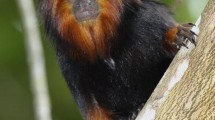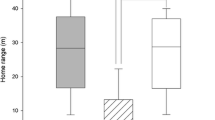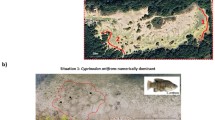Summary
Computerized screening of all the positions recorded during a synodic month on 120 individually marked chitons (Acanthopleura gemmata) pinpointed their preferential resting points. Unlike the majority of intertidal chitons so far studied, A. gemmata rests in well-defined homes actively dug in the rock. Homes proved to be not strictly individual and periodically interchangeable. A complex aggressive behaviour was recorded in the field when two animals came in contact at home. When competing for ownership of a resting site rival chitons may suppress their nocturnal feeding activity. Despite its strong home-related territoriality A. gemmata showed no mutual exclusion on the feeding area. The highly specialized resting habits clearly protects A. gemmata from its most important predator, the toad fish Arothron immaculatus. The behaviour of A. gemmata is compared to that of other chitons and gastropods, and the current hypotheses concerning the adaptive value of the homing behaviour in littoral molluscs are discussed.
Similar content being viewed by others
References
Branch GM (1975) Mechanisms reducing intraspecific competition in Patella spp.: migration, differentiation and territorial behaviour. J. Anim Ecol 44:575–600
Breen PA (1971) Homing behaviour and population regulation in the limpet Acmaea (Collisella) digitalis. Veliger 14:177–183
Chelazzi G (1980) Zonazione dinamica e meccanismi di orientamento nei molluschi litorali. Atti Accad Fisiocrit Siena 1980:275–293
Chelazzi G, Focardi S, Deneubourg JL (1983) A comparative study on the movement patterns of two sympatric tropical chitons (Mollusca: Polyplacophora). Mar Biol 74:115–125
Connor M (1975) Niche apportionment among the chitons Cyanoplax hartwegii and Mopalia muscosa and the limpets Collisella limatula and Collisella pelta under the brown alga Pelvetia fastigata. Veliger 18 (Suppl):9–17
Cook SB (1969) Experiments on homing in the limpet Siphoaria normalis. Anim Behav 17:679–682
Cook SB (1971) A study of homing behaviour in the limpet Siphonaria alteraata. Biol Bull 141:449–457
Cook SB (1976) The role of the home scar in pulmonate limpets. Bull Am Mal Union 1976:34–37
Cook SB, Cook CB (1975) Directionality in the trail-following response of the pulmonate limpet Siphonaria alternata. Mar Behav Physiol 3:147–155
Davies PS (1969) Physiological ecology of Patella. III. Desiccation effects. J Mar Biol Assoc UK 49:291–304
Frank PW (1964) On home range of limpets. Am Nat 98:99–104
Funke W (1968) Heimfindevermögen und Ortstreue bei Patella L. (Gastropoda, Prosobranchia). Occologia (Berl) 2:19–142
Galbraith RT (1965) Homing behaviour in the limpets Acmaea digitalis and Lottia gigantea. Am Midl Nat 74:245–246
Hartnoll RG, Wright JR (1977) Foraging movements and homing behaviour in the limpet Patella vulgata L. Anim Behav 25:806–810
Lewis JR (1954) Observations on a high level population of limpets. J Anim Ecol 23:85–100
MacFarlane ID (1980) Trail-following and trail-searching behaviour in homing of the intertidal gastropod mollusc, Onchidium verruculatum. Mar Behav Physiol 7: 95–108
Mackay DA, Underwood AJ (1977) Experimental studies on homing in the intertidal patellid limpet Cellana tramoserica (Sowerby). Oecologia (Berl) 30:215–237
Newell RC (1979) Biology of intertidal animals. Marine Ecological Surveys, Faversham, Kent
Pielou EC (1978) Population and community ecology: principles and methods. Gordon and Breach, New York
Schmidt-Effing U (1980) Beobachtungen zum Heimfindeverhalten und zum Aktivitäsrhythmus von Chiton stokesii Broderip, 1832 mit Anmerkungen auch zu Ischnochiton dispar (Sowerby, 1832) (Polyplacophora). Zool Anz 5/6:309–317
Smith SY (1975) Temporal and spatial activity patterns of the intertidal chiton Mopalia muscosa. Veliger 18 (Suppl):57–62
Stimson J (1970) Territorial behaviour of the owl limpet Lottia gigantea (Gray). Ecology 51:113–118
Stimson J (1973) The role of the territory in the ecology of the intertidal limpet Lottia gigantea (Gray). Ecology 54:1020–1030
Thomas RF (1973) Homing behaviour and movement rhythms in the pulmonate limpet, Siphonaria pectinata Linnaeus. Proc Malacol Soc (Lond) 40:303–311
Thorne MJ (1968) Studies on homing in the chiton Acanthozostera gemmata. Aust J Mar Freshwater Res 19:151–160
Underwood AJ (1977) Movements of intertidal gastropods. J Exp Mar Biol Ecol 26:191–201
Underwood AJ (1979) The ecology of interdial gastropods. Adv Mar Biol 16:111–201
Author information
Authors and Affiliations
Rights and permissions
About this article
Cite this article
Chelazzi, G., Focardi, S., Deneubourg, J.L. et al. Competition for the home and aggressive behaviour in the chiton Acanthopleura gemmata (Blainville) (Mollusca: Polyplacophora). Behav Ecol Sociobiol 14, 15–20 (1983). https://doi.org/10.1007/BF00366651
Received:
Accepted:
Issue Date:
DOI: https://doi.org/10.1007/BF00366651




